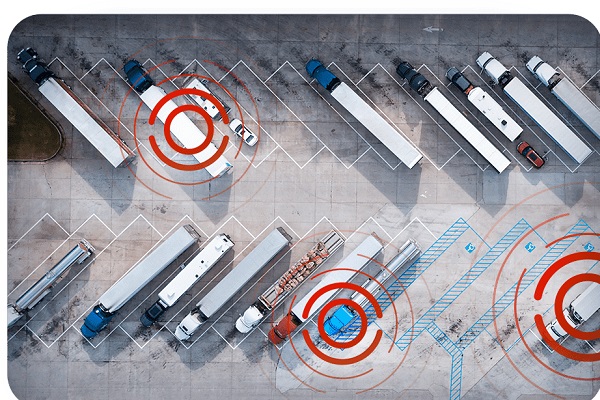
By Roni Taylor, SVP of Strategy and Business Development, Spireon, a Solera Company
October 18, 2023
It’s no secret that in the fast-paced world of logistics and transportation, staying ahead of the curve is essential for trailer managers. With the increasing demand for efficiency, advancements in trailer tracking technology have become a game changer, making available a treasure trove of data that is reshaping the operational landscape, from industry giants to smaller and medium-sized fleets (SMBs). However, the true value of this technology becomes somewhat diminished if the data isn’t effectively utilized. To truly harness its transformative power, accessibility and understanding at all levels within an organization is imperative. In this blog post, we’ll delve into the evolution of trailer tracking technology and the extensive data it generates, illustrating how it benefits operations, with a special focus on SMBs.
Revolutionizing Trailer Tracking Technology
 Long gone are the days when a basic spreadsheet sufficed for tracking trailers. In today’s hyper-competitive market, precision and efficiency reign supreme, and businesses are achieving this by embracing cutting-edge technology. However, it’s no longer just about knowing the whereabouts of your trailers. It’s about leveraging the wealth of data this technology makes available to make well-informed decisions at every level of an organization. What’s the use of this valuable data if it isn’t effectively utilized?
Long gone are the days when a basic spreadsheet sufficed for tracking trailers. In today’s hyper-competitive market, precision and efficiency reign supreme, and businesses are achieving this by embracing cutting-edge technology. However, it’s no longer just about knowing the whereabouts of your trailers. It’s about leveraging the wealth of data this technology makes available to make well-informed decisions at every level of an organization. What’s the use of this valuable data if it isn’t effectively utilized?
Making Data Digestible for All Levels
It’s important to recognize that the responsibility for understanding and leveraging this data doesn’t rest solely with fleet managers. Instead, it’s imperative for individuals at every rung of the organizational ladder to have the capability to digest and make meaningful use of information. This democratization of data ensures that everyone, from the C-suite to the frontlines, can contribute to improving productivity.
 To achieve this, companies like Spireon, a Solera company, have developed user interfaces based on customer feedback. These interfaces are designed to accommodate a wide range of user requirements, from yard check reports to landmark entry and exit reports. The goal is to provide user-friendly tools that cater to the diverse needs of different roles within a company.
To achieve this, companies like Spireon, a Solera company, have developed user interfaces based on customer feedback. These interfaces are designed to accommodate a wide range of user requirements, from yard check reports to landmark entry and exit reports. The goal is to provide user-friendly tools that cater to the diverse needs of different roles within a company.
Moreover, integration with TMS has become a standard practice. This means that critical trailer data is made seamlessly accessible to those already working within TMS interfaces. Dispatchers, customer service representatives, and other team members can access real-time trailer data without the need to learn a new user interface, enhancing operational efficiency. These services provide hands-on support for data analysis, offering valuable insights and reports that help optimize trailer management.
Leveling the Playing Field for Small and Medium-Sized Fleets
Traditionally, SMB fleets have been hesitant to invest in the latest telematics and trailer tracking technology. However, the current economic climate has shifted dramatically. In today’s market, where margins are tight, every advantage counts. Trailer tracking technology isn’t just a “nice to have,” it’s a necessity to stay afloat, which can look different from business to business. While some users may require basic trailer location data, others are venturing into more data-intensive territory.
 Consider the scenario of a tanker fleet operating in Canada during harsh winter months. Utilizing an advanced data analytics solution, they can effectively monitor the entry and duration of their trailers in Canada. This data empowers them to optimize preventative maintenance scheduling, a crucial element in maintaining operational efficiency under challenging conditions. With market dynamics favoring efficiency, investing in these technologies is the key to securing your position in the race.
Consider the scenario of a tanker fleet operating in Canada during harsh winter months. Utilizing an advanced data analytics solution, they can effectively monitor the entry and duration of their trailers in Canada. This data empowers them to optimize preventative maintenance scheduling, a crucial element in maintaining operational efficiency under challenging conditions. With market dynamics favoring efficiency, investing in these technologies is the key to securing your position in the race.
Conclusion
Advancements in trailer tracking technology have emerged as the cornerstone of efficient fleet management. By making this data available and digestible, businesses gain the ability to optimize their operations comprehensively. From user-friendly interfaces to advanced analytics and managed services, companies are empowering organizations of all sizes to make the most of this technology. By investing in these technologies, businesses can unlock new levels of efficiency, profitability, and competitiveness in an increasingly demanding industry.




